Crafting the Perfect Meat Loaf: A Culinary Guide
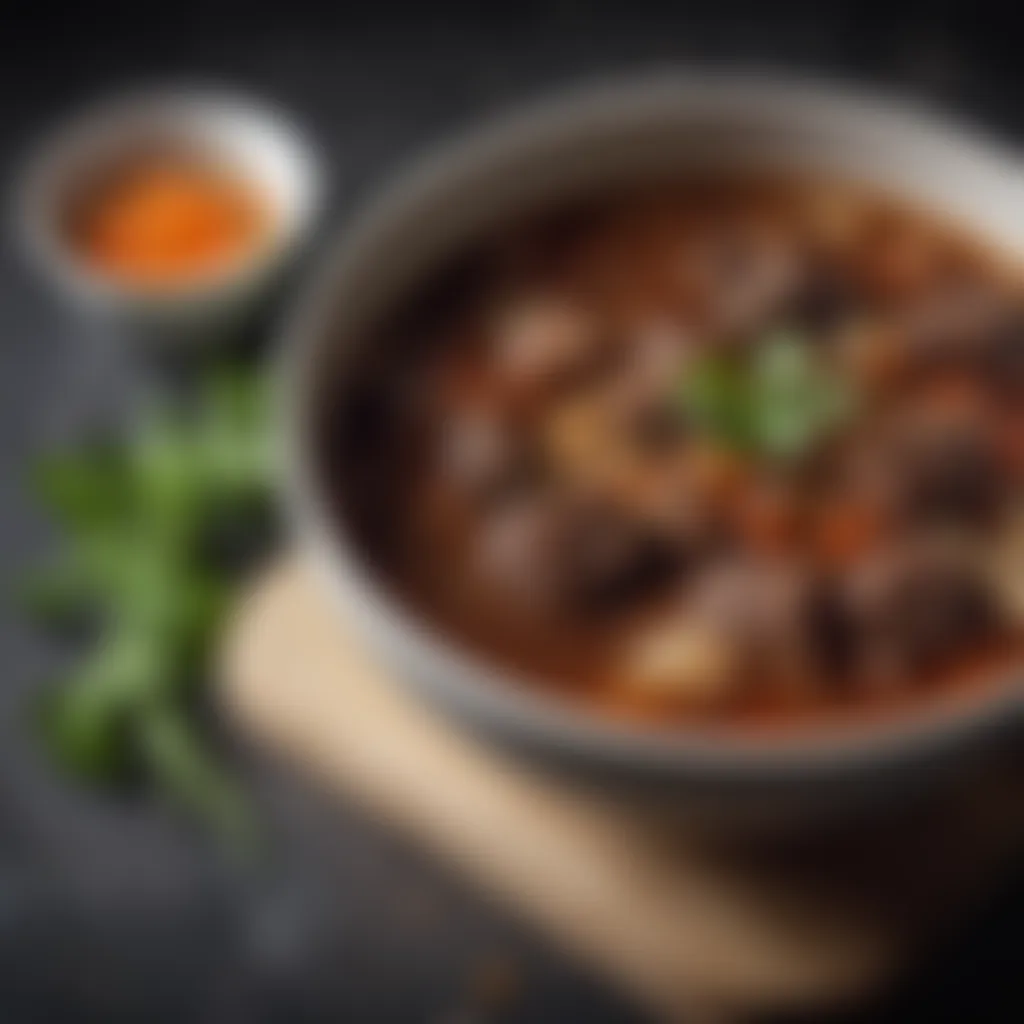
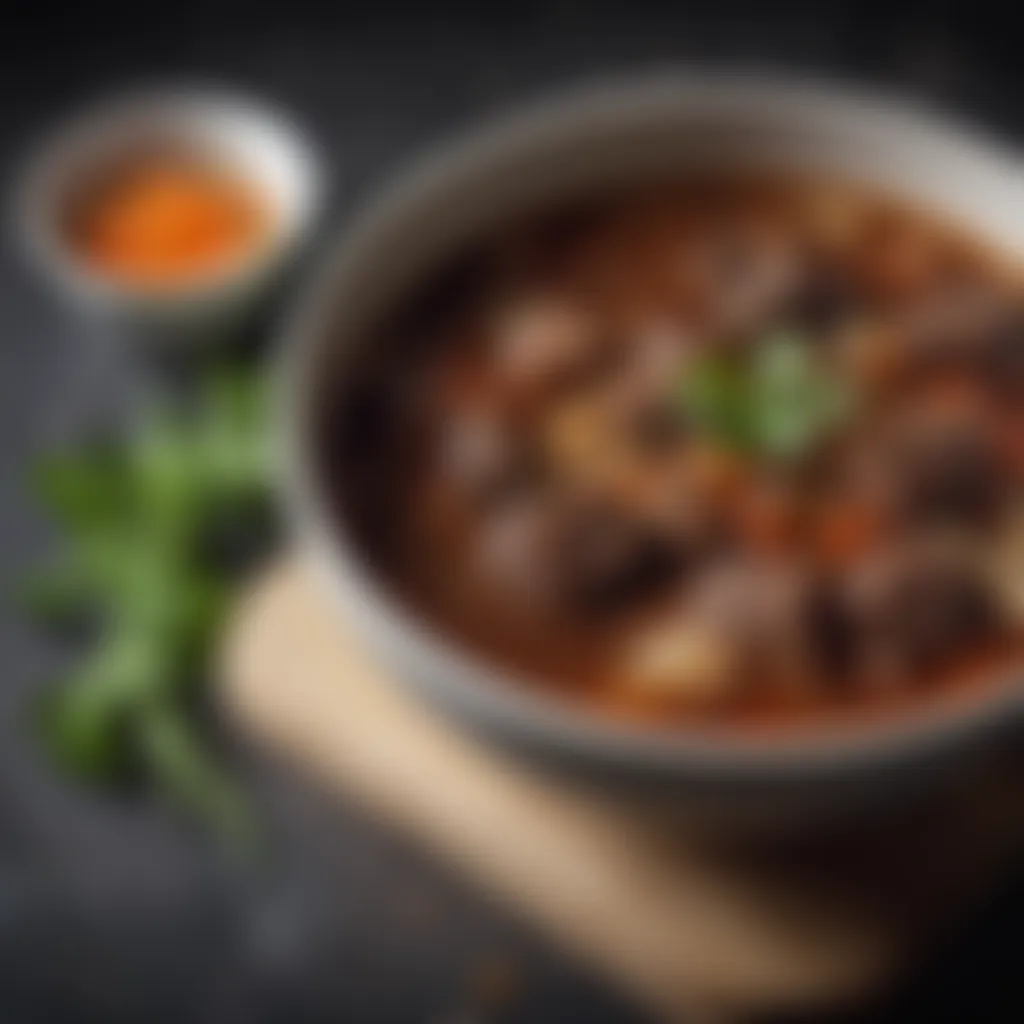
Intro
Creating the perfect meat loaf is not just about following a basic recipe; it's an art form that brings together a symphony of flavors, textures, and culinary techniques. Whether you’re a seasoned chef or a home cook looking to impress, mastering the craft of meat loaf can elevate your kitchen endeavors. This guide aims to walk you through the essential steps—from the selection of ingredients to the finishing touches on your dish—ensuring that you produce a meat loaf worthy of admiration.
Ingredients:
A careful selection of ingredients is the foundation of any successful meat loaf. Each component plays a vital role in building flavor, moisture, and structure. Below is a detailed list of everything you will need to get started:
- Ground Meat: 1.5 pounds of ground beef (80/20 for best flavor)
- Pork: 0.5 pounds of ground pork
- Breadcrumbs: 1 cup of seasoned breadcrumbs
- Onion: 1 medium onion, finely chopped
- Garlic: 2 cloves of garlic, minced
- Eggs: 2 large eggs
- Milk: 1/2 cup whole milk
- Ketchup: 1/2 cup, plus more for glaze
- Worcestershire Sauce: 1 tablespoon
- Salt: 1 teaspoon, or to taste
- Black Pepper: 1/2 teaspoon, or to taste
- Herbs and Spices: 1 teaspoon dried oregano, 1 teaspoon dried thyme, and 1 teaspoon smoked paprika
- Bell Pepper: 1/2 cup finely chopped bell pepper (optional, for sweetness)
Preparation Steps:
To bring your meat loaf to life, you’ll want to ensure that each ingredient is prepared with precision. Follow these detailed instructions:
- Preheat the Oven: Start by preheating your oven to 350°F (175°C).
- Sauté the Vegetables: In a skillet over medium heat, add a touch of oil. Sauté the chopped onion and garlic until they are soft and fragrant, around 5 minutes. This step builds a deeper flavor base.
- Combine the Meats: In a large mixing bowl, combine the ground beef and pork. Use your hands or a spoon to mix gently, being careful not to overwork.
- Add the Ingredients: Incorporate breadcrumbs, sautéed onion and garlic, ketchup, Worcestershire sauce, milk, egg, and the herbs/spices. Mix just until combined—think of it like a gentle fold, ensuring everything is well-distributed without turning the mixture into mush.
- Form the Loaf: Transfer the meat mixture onto a baking sheet lined with parchment paper. Shape it into a loaf form, about 2 inches thick. Use a spatula to smooth the top and sides.
Technical Aspects:
Understanding the technical aspects of cooking will greatly enhance your meat loaf. Here are some specifics to keep in mind:
- Temperature: Set your oven to 350°F (175°C) for optimal cooking.
- Timing: Bake for 1 hour. Using a meat thermometer, the internal temperature should read 160°F (70°C) for safety.
- Glazing: About 15 minutes before it’s done, brush the top with additional ketchup for a glossy finish.
Cooking Process:
Follow these sequential steps to ensure proper cooking:
- Place the loaf in the preheated oven and let it bake.
- At the 30-minute mark, check for any browning. If it looks too dark, you can loosely cover it with aluminum foil to prevent burning.
- When the hour is up, use a meat thermometer to confirm the temperature. If you need to cook longer, in 5-minute increments, keep checking until the right temp is achieved.
- Once done, take it out and let it rest for at least 10 minutes before slicing. This resting period helps to maintain moisture.
Troubleshooting Tips:
Even the best chefs encounter hiccups in the kitchen. Here are some common issues and solutions:
- Dry Meat Loaf: Ensure not to overmix the ingredients and use the right fat content in your meat. The 80/20 beef achieves a nice balance of juiciness.
- Meat Loaf Falls Apart: If your meat loaf isn’t holding together, consider adding more breadcrumbs or an additional egg to help bind the mixture.
- Uneven Cooking: If your meat loaf browns too quickly, lower the oven temperature or cover with foil to slow down the cooking.
Remember, mastering the meat loaf is about patience and practice. Each time you make it, you’ll learn something new and get closer to your culinary perfection.
Preamble to Meat Loaf as a Culinary Art
When one thinks of comfort food, meat loaf is often at the forefront. It’s a dish that evokes warm memories from family gatherings and hearty dinners, seamlessly bridging the gap between nourishing meals and culinary creativity. The importance of exploring meat loaf as a culinary art stems from its history rich with cultural significance and its ability to adapt to seasonal ingredients and personal preferences.
Meat loaf is much more than mixing some ground meat and spices; it represents a canvas waiting for an artist's touch. This dish presents an opportunity for every cook to express themselves by experimenting with flavors, textures, and techniques. Understanding the mechanics of good meat loaf can empower anyone in the kitchen, whether you're a busy housewife or a culinary novice.
Each ingredient counts. Selecting the right types of meat, fillings, and seasonings can transform a mediocre meal into a culinary delight. Moreover, mastering this dish means learning about balancing moistness and structure, which is a challenge that can reward chefs with a sense of accomplishment.
As we delve into the historical context and cultural significance, we uncover layers of meaning in what could be perceived as just a simple loaf of meat. This article aims to elevate your understanding and skill in meat loaf preparation, turning a humble dish into a masterpiece that can be enjoyed by all.
Historical Context of Meat Loaf
Meat loaf's origin can be traced back centuries, with roots in various forms across the globe. The concept of ground or minced meat shaped into a loaf-like form has appeared in ancient Roman literature and even existed in the culinary lexicon of 19th-century America. In those bygone days, people made what they could with limited resources, leading to innovative approaches to meat preparation. As times changed, so did the methods of making meat dishes.
In America, meat loaf became a popular dish during the Great Depression, embodying the necessity of stretching every penny without sacrificing flavor. It showed up on diner menus and was a staple in many households. With each generation, variations arose, reflecting the local tastes and available ingredients, making its story long and rich. To appreciate meat loaf fully, it's essential to recognize how it has adapted through time and geography.
Cultural Significance in Various Cuisines
Much like a blank canvas eager for paint, meat loaf has adapted itself to different cultures in fascinating ways. From the Italian polpettone to the Swedish kottfarslimpa, variations abound, each showcasing local flavors and traditions.
- Italian Meat Loaf: Typically, this version incorporates herbs like basil and parsley, along with the addition of cheese, making it so flavorful that it's often served on festive occasions.
- Swedish Köttfärslimpa: This iteration diverges slightly with a blend of spices that cater to Scandinavian palates, often served with lingonberry sauce for a touch of sweetness.
- Middle Eastern Influences: The incorporation of spices such as cinnamon and nutmeg can create a uniquely flavored meat loaf, which pairs well with rice or flatbreads.
Adapting recipes to local tastes not only pays homage to the heritage but also allows for a culinary conversation that transcends borders. Each
Ingredient Selection: The Foundation of Flavor
When it comes to creating a sumptuous meat loaf, the importance of ingredient selection cannot be overstated. This pivotal stage lays the groundwork for the flavors and textures that will ultimately define this dish. Not only do the ingredients impart their unique characteristics to the meat loaf, but they also interact in ways that elevate the end result. Understanding how to choose the right components ensures not just a good meal, but a great one.
Types of Meat: Choosing the Right Blend
Beef Variants
Beef is often the star player when it comes to meat loaf. It brings a rich flavor and is quite versatile, allowing for various cuts to be used. For example, lean ground beef typically results in a drier loaf while fattier options like chuck lend a buttery richness, ensuring moistness.
A typical blend might involve loose cuts that have the right marbling. The key characteristic of beef is its robust flavor, making it a favorite among most meat loaf enthusiasts. The unique feature of incorporating beef variants is the option to mix different styles; some might opt for a combination of ground sirloin and ground chuck, achieving a balance between flavor and texture. While it is a popular choice, one should be cautious of the fat content to prevent the loaf from becoming greasy or too dense.
Alternative Proteins
In our modern culinary landscape, alternative proteins are gaining traction for various reasons, including health concerns and dietary choices. Choices such as turkey or chicken bring a lighter taste and a lower fat content. They often result in a fluffier texture, which can be refreshing for those tired of traditional beef.
The highlight of using alternative proteins is their adaptability; they absorb flavors beautifully when paired with the right herbs and spices. However, the distinct taste might not satisfy everyone, especially if one is seeking the intense flavors that beef provides. A common disadvantage may lie in the tendency for the meat loaf to be slightly drier, which can be mitigated through careful moisture retention techniques.
Plant-Based Options
More people are looking to meat-free choices for their meals, making plant-based options an intriguing and popular choice. Ingredients like lentils, mushrooms, and even tofu can offer an excellent base. What's particularly beneficial about plant-based ingredients is that they often introduce complex flavors and satisfying textures without the richness of meat.
The unique feature of plant-based options is their ability to absorb seasonings and sauces exceptionally well. This can give the meat loaf an impressive flavor profile that rivals its meat counterparts. One challenge, though, is achieving the same satisfying texture one might get from meat, requiring creative adaptations in binding agents to keep the loaf intact.
The Role of Fillers and Binders
Fillers and binders bring their own set of benefits to the meat loaf tapestry, contributing to the structure and moisture retention of the final dish. These elements can vary widely, impacting both flavor and texture.
Breadcrumbs
Breadcrumbs are a traditional favorite for filling a meat loaf. They serve to absorb moisture and keep the mix stable while baking. A common choice is using fresh breadcrumbs soaked in milk for a softer texture.
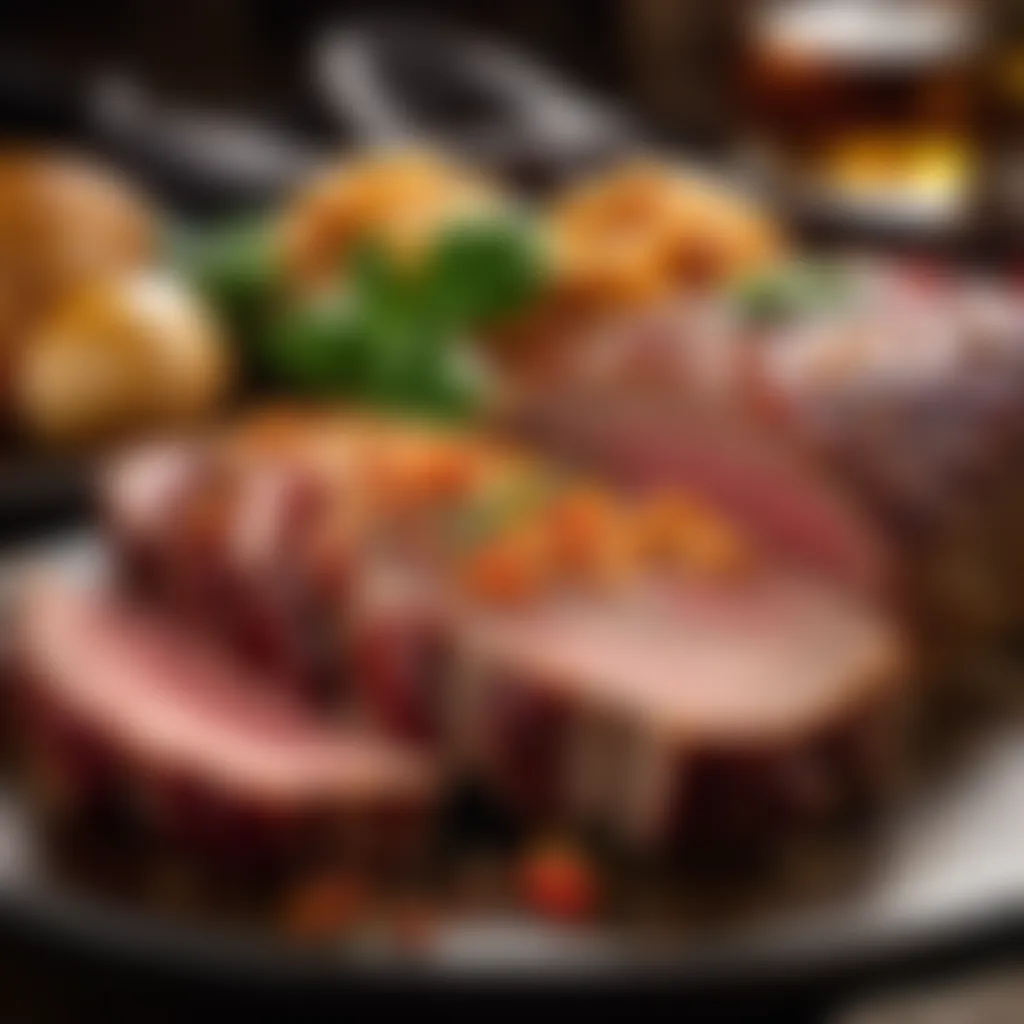
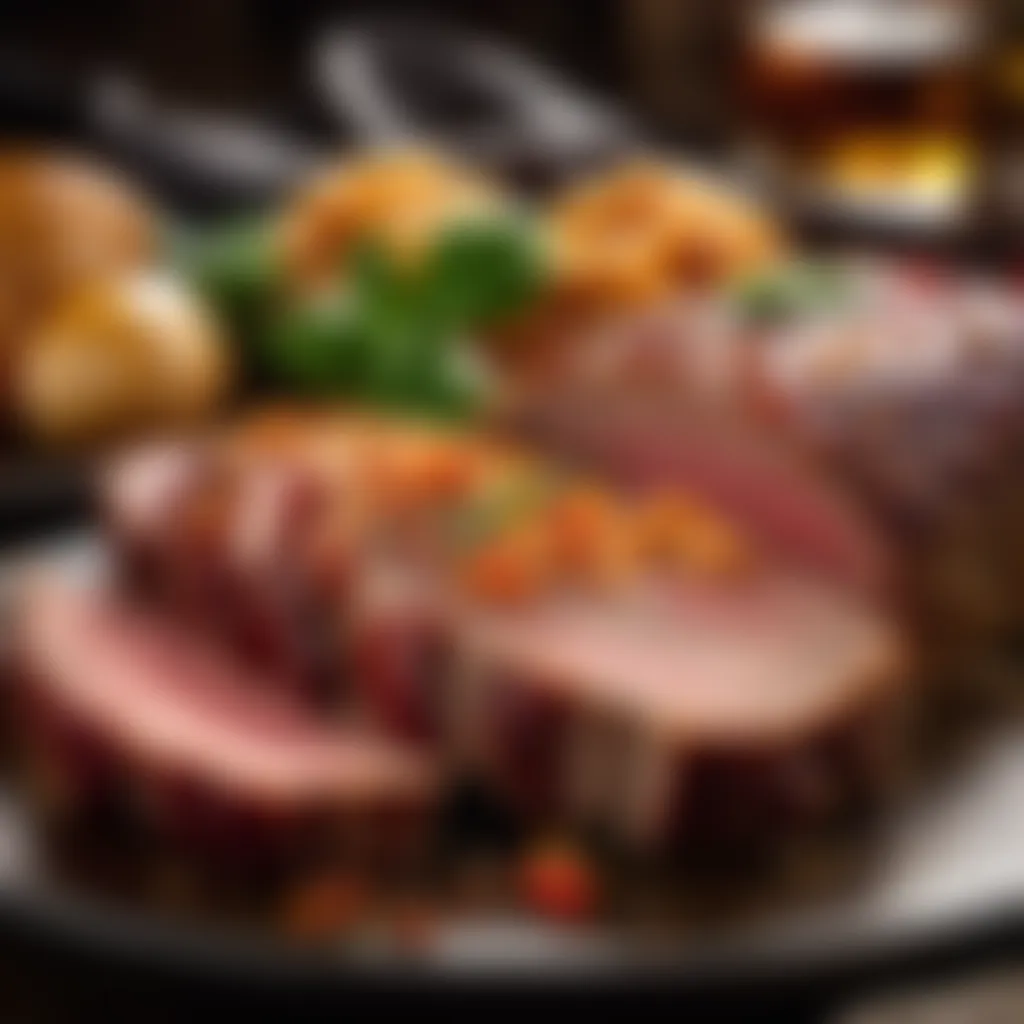
The essential characteristic of breadcrumbs is their ability to blend seamlessly into the mixture. This makes it a beloved yet simple addition. While breadcrumbs do a fine job, one must be wary about their quantity as too much can dry out the loaf, making it crumbly and less enjoyable.
Rice and Grains
Incorporating rice or other grains like quinoa or farro can add an unexpected yet delightful twist to meat loaf. These options not only contribute fiber but also create an appealing texture.
The notable feature of using rice or grains is the variety they introduce. They also enhance the nutritional profile of the dish, making it a more balanced meal. However, balancing their quantity alongside meat is crucial; too much might overpower the primary flavor of the meat itself, leading to an unsatisfactory outcome.
Vegetable Add-ins
Adding vegetables can elevate the meat loaf by infusing it with vitamins and unique tastes. Chopped onions or peppers, for instance, contribute moisture and enhance flavor without overwhelming the mix.
The advantage of vegetable add-ins lies in their ability to create layers of flavor and texture that can make every bite unique. They allow for creativity, welcoming seasonal or regional produce into the mix. On the downside, excessive moisture from some vegetables can lead to a soggy loaf, which is best avoided through proper preparation.
Herbs and Spices: Enhancing Flavor Profiles
Herbs and spices are the unsung heroes of any meat loaf, transforming the ordinary into the extraordinary. Choosing the right combination can breathe life into what may seem like a simple dish.
Classic Combinations
Classic combinations, such as parsley, thyme, and black pepper, serve as the backbone of many meat loaf recipes. These staples provide a base flavor, enhancing the meat without overshadowing it.
The key feature of these classics is their universal appeal; they create a comforting familiarity that resonates with many. A potential drawback, however, lies in relying too heavily on these common combinations, as they can become predictable over time.
Regional Seasoning Influences
Exploring regional seasoning influences offers a chance to add personality and flair to a meat loaf. For instance, incorporating Italian herbs can offer a Mediterranean flair while using curry powder might open up flavors reminiscent of Indian cuisine.
The essential characteristic of this approach is its diversity, opening up avenues for creativity. Experimenting with unique spices can elevate a meat loaf from humble beginnings to something quite remarkable. A potential issue is that some unique spice blends may not resonate with a broader audience, so it's essential to tread carefully and taste as you go.
The right blend of meat, fillers, and seasonings can transform a simple meat loaf into an unforgettable culinary experience.
Preparing the Perfect Meat Loaf Mixture
Creating the perfect meat loaf comes down to a simple truth: the mixture sets the stage for the entire dish. The combination of elements in this mixture isn’t just a matter of taste; it determines the texture, moisture level, and ultimately, the success of the meat loaf. Understanding this foundational step guides the culinary enthusiast toward achieving that cherished slice of comfort food.
Mixing Techniques for Optimal Texture
Hand Mixing vs. Mechanical Methods
When it comes to preparing the meat loaf mixture, there's often debate over whether to use your hands or a mechanical tool. Hand mixing tends to yield a more personal touch. One key characteristic of hand mixing is that it allows you to feel the texture, making it easier to achieve that perfect uniformity without overworking the meat. This method is particularly advantageous because it promotes a tender meat loaf. However, it can feel a bit tedious, especially if you’re making a larger batch.
On the other hand, mechanical methods—like using a stand mixer—offer speed and efficiency. While mixing with a machine might save time, it runs the risk of overmixing, leading to a denser loaf. This choice often hinges on how you like to spend your kitchen time; if you find satisfaction in tactile engagement, then hand mixing is the way to go.
Importance of Consistency
Consistency is another vital aspect to consider when preparing your meat loaf mixture. Achieving the right consistency means balancing ingredients so that the mixture isn’t too loose or overly compact. The key characteristic of a well-consistent mixture is that it holds together while being moist enough to ensure a juicy outcome. This balance is crucial because a mixture that's too wet can lead to a mushy end product, while one that’s too dry becomes as tough as shoe leather. In this article's context, consistency enhances the overall experience of the dish, ensuring each bite is satisfying. Keeping an eye on the ingredient ratios is essential for maintaining this balance, allowing you to aim for that perfect meat loaf each and every time.
Achieving the Ideal Moisture Balance
Utilizing Moisture Retaining Ingredients
Moisture retention is at the heart of a successful meat loaf. The specific aspect here is incorporating ingredients like soaked breadcrumbs, grated vegetables, or even moist spices that can keep the meat loaf from drying out during the baking process. A notable characteristic of utilizing moisture-retaining ingredients is that they not only add flavor but also create a lush texture that leaves your taste buds dancing. In the article’s framework, these ingredients are highlighted as game-changers. They serve as a means of support, helping to keep that inner warmth and juiciness intact. However, too much of these ingredients can also lead to an overly soggy mixture, which is something to watch out for.
Monitoring Fat Content
The fat content in your meat loaf is another crucial consideration. Pay attention here! The key characteristic of monitoring fat content lies in the balance between flavor and health. A certain amount of fat is necessary for flavor; too little can result in a bland loaf, while excessive fat can yield greasy slices that leave you reaching for the napkin. It’s about finding that sweet spot of richness. This aspect is also a beneficial choice in this article. By understanding your fat sources—whether from the meat itself or added fats like bacon or cheese—you can customize the moisture level in your meat loaf while ensuring every bite is deliciously satisfying. The careful monitoring here can truly elevate your dish from ordinary to extraordinary.
Shaping and Baking: Techniques for Success
Shaping and baking are crucial components in the craft of meat loaf. They influence not only the visual appeal but also the texture and flavor profile of the final dish. A well-shaped meat loaf maintains its structure during baking, ensuring that every slice reveals a uniform look while retaining its juicy goodness inside. Proper baking techniques help in achieving that elusive balance of a crispy exterior and a tender center.
Forming Techniques: Loaf vs. Muffin
When it comes to shaping your meat loaf, the classic loaf shape is often preferred, but muffin-style meat loaves have gained popularity too. The traditional loaf allows for more generous servings and retains moisture effectively. On the other hand, muffin-sized portions offer great convenience for both cooking and serving.
This method can also be fun to experiment with flavors as you can create a variety of mini meat loaves - perhaps some with cheese inside, or a hint of barbecue sauce. No matter your choice, the secret lies in creating a tight yet not overly compact form that cooks evenly.
Choosing the Right Baking Vessel
Selecting the appropriate baking vessel is integral to a successful meat loaf. Here, we compare loaf pans with freeform options to illustrate their benefits and drawbacks.
Loaf Pans
Loaf pans are quite popular for cooking meat loaf due to their uniform shape. The main characteristic of a loaf pan is its high, straight sides, which encourage even browning and proper cooking. By using a loaf pan, you’ll find that the meat loaf holds its shape exceptionally well, making for easy slicing once it’s cooked. This method tends to minimize the potential for moisture loss.
However, there is a consideration to keep in mind: too much fat can accumulate in the bottom, so it’s essential to keep an eye on fat content during preparation. A slight risk lies in the meat loaf becoming overly steamed if it’s wrapped tightly.
"A proper meat loaf deserves the best vessel; it sets the stage for a perfect bake.”
Freeform Options
When opting for freeform meat loaves, you embrace a more rustic style. The beauty of freeform cooking speaks to the homey aspect of meat loaf. You can shape it on a baking sheet or even parchment paper; this allows for crust exposure all around, resulting in a delightful browning effect. Additionally, it gives you the flexibility to experiment with shape and size, whether you want something thicker in the center or shallower on the edges.
While freeform options may require more vigilance to maintain the loaf shape during cooking, they allow the cook to express creativity in a way that standard loaf pans do not.
Temperature and Timing: Ensuring Perfection
The right temperature and timing are key players in the meat loaf game. They ensure you achieve the best texture and flavor.
Preheating Essentials
Preheating your oven is not just a formality; it's a necessity. The key characteristic of preheating is that it establishes a consistent baking environment before your meat loaf enters. This helps the outside form a crust quickly, sealing in moisture and flavor right from the get-go. It’s often said, “A quick start is half the battle.” Uneven preheating can lead to an unevenly cooked meat loaf, which never ends well in terms of satisfaction.
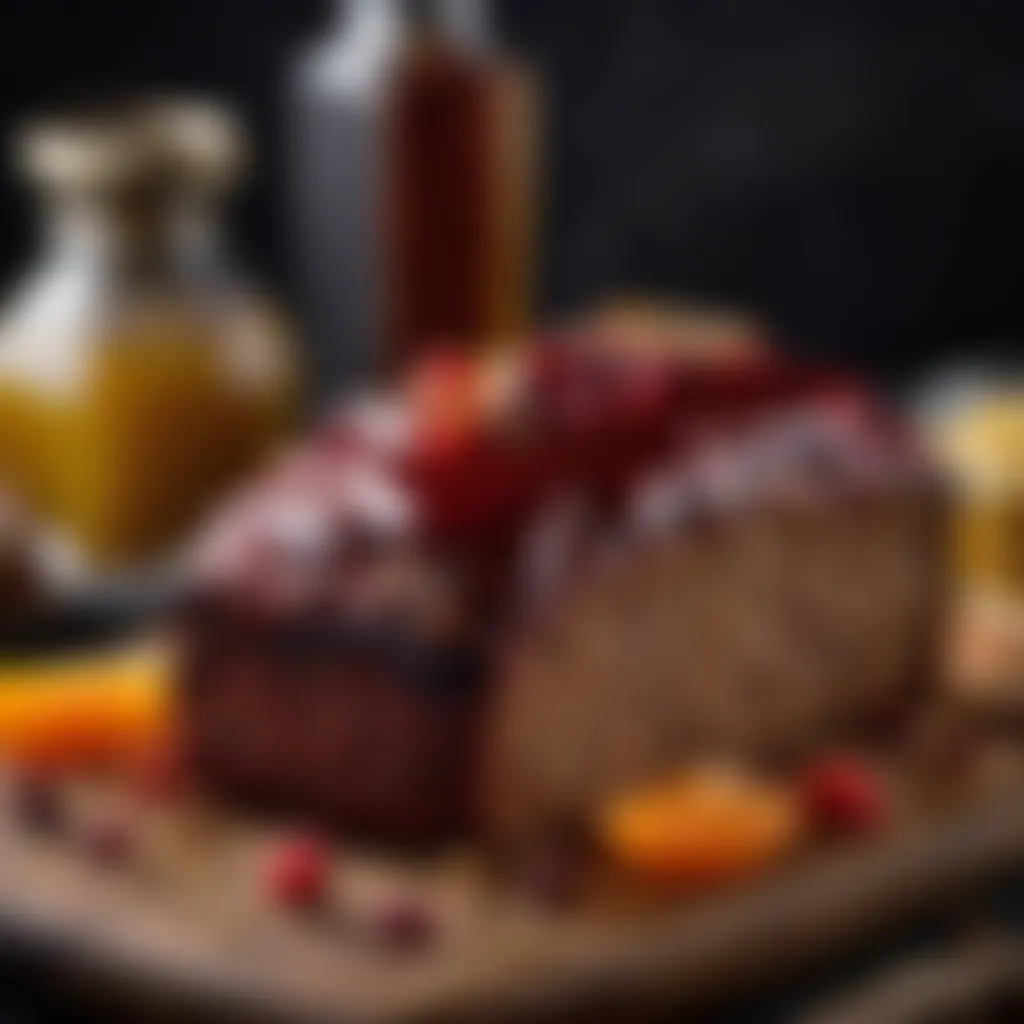
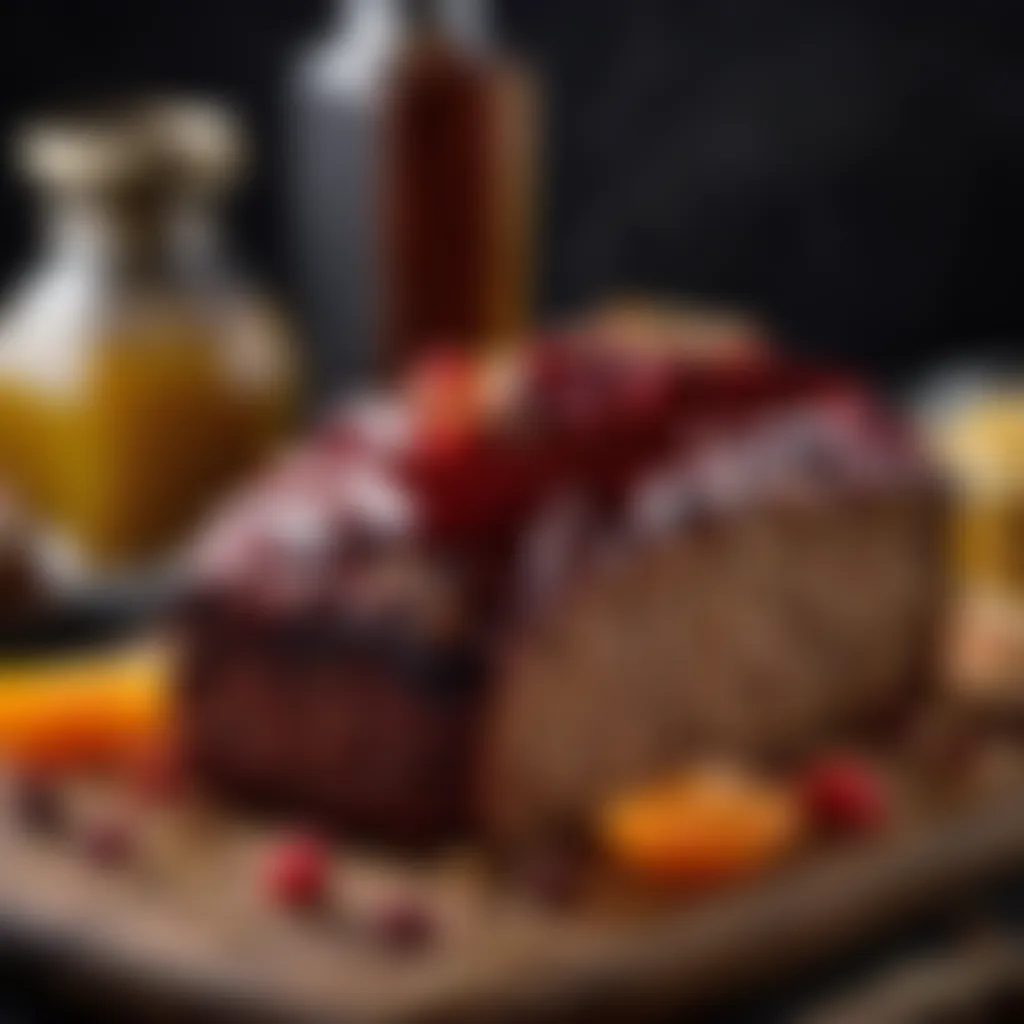
An adequately preheated oven generally helps in creating a desirable crust while keeping the interior juicy. If the temperatures fluctuate a lot because of neglecting to preheat, you might end up with a soggy loaf.
Understanding Carryover Cooking
Carryover cooking refers to the phenomenon where food continues to cook even after being removed from heat. This is particularly crucial for meat loaf since it can be dense, and the interior might still need a bit more time to reach that perfectly cooked state.
When you pull your meat loaf from the oven, you might feel tempted to cut right into it, but holding off for about 10-15 minutes allows the meat loaf to stabilize. The internal temperature will continue to rise, rounding out your cooking effort nicely. If you don't consider this factor, you might risk serving a loaf that is just a tad underdone, which is never favorable for a family meal.
Glazes and Toppings: Elevating the Dish
In the realm of meat loaf, the glaze and toppings hold a kind of magic, transforming an everyday dish into a culinary statement. They not only offer a shiny and appealing look but also layer flavors that can take your meat loaf from simple to spectacular. Think of the glaze as the icing on a cake; it’s that finishing touch that makes a world of difference. Without it, your meat loaf might seem bland or lackluster by comparison.
A well-crafted glaze enhances moisture, adds flavor, and contributes to a mouthwatering aroma as the loaf cooks. Choosing the right glaze can be just as crucial as deciding on the meat itself. It informs diners of what tastes lie ahead and prepares their palate for a vibrant experience.
Furthermore, toppings can add texture, surprise, or even a regionally inspired twist. The blend of sweet and savory, spicy and tangy, challenges the senses and invites an exploration of taste.
Traditional Glaze Recipes
Traditional glaze recipes often hail from the heart of family kitchens. Commonly, a ketchup-based glaze is the classic choice for many home cooks. Its sweet and tangy qualities harmonize excellently with the savory elements of the meat loaf. Alternatively, a mixture of brown sugar, mustard, and Worcestershire sauce can yield a savory-sweet glaze that not only complements but enhances the main dish.
Here are a few staples:
- Ketchup and Brown Sugar: A timeless favorite, this glaze caramellizes as it bakes.
- BBQ Sauce: For those who crave bold flavors, BBQ sauce can impart a smokey, sweet touch.
- Mustard Mix: Combining mustard with honey and apple cider vinegar creates a zesty kick.
These old-school traditions, passed down through generations, should not be overlooked. They carry with them stories and flavors that can transform your meat loaf into something distinctly personal.
Modern Variations and Trends
In today's culinary landscape, folks are venturing beyond the classic ketchup glaze, experimenting with bold alternatives.
Gluten-Free Options
The inclusion of gluten-free options represents a significant trend in modern cooking. With many individuals adopting gluten-free diets, it's important to recognize how this impacts our approach to glazes. A gluten-free glaze often relies on ingredients like pureed fruits, honey, or various vinegars, which can create a stickiness and richness without any wheat products.
This adaptation is a beneficial choice as it expands the audience for your meat loaf. By accommodating dietary preferences, you open the door to cooking for friends and family who might otherwise miss out. The unique feature of gluten-free glazes is their ability to combine textures and flavors in new ways, often pairing well with herbs or citrus zest.
Unique Flavor Pairings
The trend of unique flavor pairings complements the traditional approach beautifully, encouraging a culinary creativity that was not previously as common. Incorporating elements like chipotle peppers in adobo sauce or miso paste can offer unexpected depth to the glaze. Using soy sauce with a hint of pineapple transforms the glaze by introducing umami and sweetness. This forward-thinking approach adds excitement and invites diners to return for second helpings.
Unique flavor pairings present an opportunity to create an experience. They intrigue the palate and invite a memorable impression upon those who partake. The versatility found in modern glazes helps in mastering the art of meat loaf, making it not just a dish but a signature culinary adventure.
In closing, the role of glazes and toppings in meat loaf cannot be overstated. They are the finishing details that can elevate an ordinary meal into something extraordinary, creating a feast for the eyes and the palate alike. Experimenting with these techniques could set the stage for memorable gatherings around the dinner table.
Sides and Accompaniments: A Balanced Meal
When it comes to crafting the ultimate meat loaf experience, it's easy to overlook what sits alongside the star of the show. However, sides and accompaniments are not just an afterthought; they play a crucial role in balancing flavors and textures, enhancing the entire meal. A well-selected side can elevate the meat loaf, complementing its rich taste and adding contrast that leaves a lasting impression.
Using proper pairings can also bring out the best in your main dish. This section covers two categories: the classic staples that have stood the test of time and innovative options that can add a fresh twist to your dining experience.
Classic Pairings
Mashed Potatoes
Mashed potatoes, with their creamy texture and simple flavor, are a classic accompaniment to meat loaf. The smooth consistency pairs gorgeously with the often dense meat loaf, bridging the gap between textures on the plate. One of its key characteristics is the ability to soak up the savory juices that flow from the meat loaf while offering a comforting mouthfeel that resonates with diners, making it a thoroughly popular choice.
The unique feature of mashed potatoes is their versatility. You can adjust them to suit personal preferences—think garlic-infused, loaded with cheese, or even a touch of herbs. However, one downside to consider is that they can sometimes add a heavy feel to the meal, particularly if portion sizes aren't managed well. Keeping that in mind allows you to provide a satisfying yet balanced dining experience.
Green Vegetables
Green vegetables, such as steamed broccoli or sautéed green beans, serve a dual purpose on the plate. They don't just add vibrant color but also a crispy freshness that contrasts beautifully with the meat loaf's rich texture. Their key characteristic lies in their nutritional value—they provide essential vitamins and minerals that round out the meal nutritionally and visually.
The unique aspect here is how easily green vegetables can take on additional flavors through seasoning or sauces. This adaptability makes them a beneficial choice since they can cater to various palates without being overly heavy or complicated. While some may argue they detract from the flavors of the meat loaf, the crunchiness they provide actually enhances the overall experience, creating a well-rounded dining affair.
Innovative Sides to Consider
Salads with Depth
As diners increasingly lean toward lighter fare, adding a salad with depth can be a game-changer. These salads combine contrasting textures and bold flavors, enriching the meat loaf on the plate. A salad that features ingredients like roasted nuts, crisp greens, and tangy dressings can truly elevate the experience.
The key characteristic of such salads is their complexity. They often include unexpected elements, such as fruits or grains, which make each bite an adventure. This makes them not only a beautiful accompaniment but also a conversation starter. A challenge, though, might be ensuring the salad doesn't overwhelm the meal or clash with the meat loaf's flavors.
Exotic Grains
While the focus often falls on traditional sides, exotic grains like quinoa or farro invite intrigue and flavor to the table. These grains not only provide a nutritional boost but also enhance the meal in unexpected ways. With their distinct textures and nutty flavors, exotic grains can create an appealing contrast to the meat loaf.
Their uniqueness lies in their ability to absorb flavors well and offer a delightful chewiness. However, a potential drawback is that some people might not be familiar with these options, leading to a hesitation in trying them out. Educating your guests about the benefits and preparation methods can mitigate this and turn them into a sought-after side dish.
"A delightful side can transform an ordinary meal into a culinary experience that lingers long after the last bite."
Bringing in sides and accompaniments that enhance, contrast, or complement the meat loaf creates not just a balanced meal but a memorable one. Choosing the right ones can elevate your dish from standard comfort food to a culinary delight.
Plating Meat Loaf: Presentation Matters
Plating might seem like a mere afterthought in the culinary world, but it plays a pivotal role in the overall dining experience, especially when it comes to meat loaf. After all the hard work that goes into crafting that delicious masterpiece, presenting it well can accentuate its appeal and elevate the meal from ordinary to extraordinary. A well-plated dish creates an inviting atmosphere and entices one's appetite even before the first bite. The visual elements can communicate a lot about the meal, including texture and freshness, making the presentation crucial.
When plating meat loaf, consider the colors, shapes, and arrangement on the plate. Balancing the meat loaf with vibrant side dishes, using contrasting colors, and ensuring the meat loaf itself is sliced neatly can all enhance its visual appeal. Not to mention, a clean plate can serve as a canvas that emphasizes the food in focus, drawing attention to the central dish.
Even small details such as the choice of plate and the arrangement of the sides on the plate can yield significant results. This all supports the idea that the presentation of the meat loaf is as important as its flavor profile. With each element in harmony, the meal becomes a feast not just for the stomach, but for the eyes too.
Creating a Visual Appeal


Creating a visual appeal in your meat loaf requires a good eye for detail. One easy tip is to slice the meat loaf evenly, showcasing its tender interior. The slices should display an appealing array of textures, presenting the well-blended ingredients inside. Placing the meat loaf on a spacious, contrasting plate also allows it to take center stage.
Pairing it with bright accompaniments - such as a colorful salad or roasted vegetables - can create a striking contrast that pops against the meat loaf. Furthermore, a thoughtful drizzle of sauce can add vivid color while also enhancing flavor. It’s this attention to detail that causes the presentation to resonate with diners.
Garnishing Techniques
Garnishing can elevate a dish and make it look professionally crafted. There are many techniques you can employ when garnishing meat loaf, with edible flowers and herb sprigs being popular choices that bring both beauty and flavor.
Edible Flowers
Edible flowers offer a unique appeal to any dish, meat loaf included. The vibrant colors of flowers can brighten the plate and provide a splash of freshness that counterbalances the hearty character of the meat. One key characteristic of edible flowers is their variety. From nasturtiums to lavender, each type adds its own unique flavor and aesthetic quality.
In the context of meat loaf, edible flowers serve as a beautiful finish that can impress guests. They are beneficial because they not only serve as decoration but can also contribute subtly to the flavor profile without overshadowing the meat loaf itself. It’s worthwhile to consider that while edible flowers are generally safe, ensuring they are indeed edible and sourced from safe areas is essential.
Herb Sprigs
Herb sprigs are another fantastic option for garnishing meat loaf. They add a burst of green that can make a plate look fresh and lively. A common choice is parsley, with its delicate leaves providing a classic touch. The aroma from the herbs can even whet the appetite, hinting at the flavors found within the dish.
Herb sprigs are popular due to their versatility and accessibility. They can be easily chopped or used whole depending on the look you want. This simple garnish ties the meal together, adding a final touch that can elevate the overall dining experience. However, be mindful with quantities used, as too many herbs can easily take away from the star of the plate – the meat loaf.
Remember, plating is not just about aesthetics; it’s about creating an experience. A well-plated meat loaf speaks of care and precision, reflecting the effort put into its preparation.
Through thoughtful plating and garnishing, meat loaf can transform from a humble weekday meal to an impressive centerpiece worthy of any occasion.
Leftovers and Versatility: Reinventing Flavors
When it comes to enjoying meat loaf, one might not consider the dish to be particularly adaptable at first glance. However, the concept of leftovers can truly breathe new life into this classic meal. After all, what’s better than a star dish becoming the foundation for a new culinary adventure? Leveraging leftovers is not only practical but also a creative outlet. It can help in reducing food waste while saving time and money. This section explores how you can channel your inner chef to turn last night’s meat loaf into something spectacular, enhancing flavors and offering fresh experiences.
Strategies for Leftover Utilization
Meat Loaf Sandwiches
One of the most beloved ways to reinvent leftover meat loaf is through the construction of hearty meat loaf sandwiches. These sandwiches can be a rockstar in the lunch department, easily elevating a simple meal into a delightful experience.
The key characteristic of meat loaf sandwiches is their ability to be customized to individual tastes. Whether one prefers a classic approach with ketchup on soft white bread or a gourmet twist with avocado and spicy aioli on artisanal sourdough, the options are virtually limitless. The unique feature of meat loaf sandwiches lies in their versatility, allowing you to mix flavors to your liking—from savory to sweet, spicy to tangy. This adaptability makes meat loaf sandwiches a beneficial choice for those looking to reinvent their leftovers.
However, it’s essential to consider moisture levels. Unlike fresh meat loaf, leftover portions can dry out. Hence, it’s wise to include fresh veggies or moist spreads to enhance flavor and texture. With careful consideration, a meat loaf sandwich can be a fantastic throw-together meal that keeps things interesting in the kitchen.
Casseroles and Other Dishes
Another impressive way to utilize leftover meat loaf is by transforming it into casseroles or other dishes. This method not only prolongs the life of your meal but also allows for creative expression. The blending of a sturdy meat loaf with creamy sauces, pasta, and cheese can result in a deliciously satisfying casserole that becomes a comforting centerpiece for any table.
The standout aspect of casseroles is their capacity to be reimagined. You might think of the mustard and cheese sauce that melds beautifully with leftover meat loaf, creating a dish that’s warm and inviting. Adding in vegetables, grains, or various sauces can turn a simple dish into a hearty family meal. The unique blend of flavors and textures provides layers of satisfaction that one might miss out on in a standalone meat loaf.
However, as with any culinary creation, balance is key. Ensure that while adding new ingredients, you don’t overpower the initial flavors of the meat loaf—aim for harmony. While casseroles may be more time-consuming than a straightforward sandwich, they exhibit creativity and offer a heartwarming result that can delight the entire family.
"Turning leftover meat loaf into exciting new dishes means you get to enjoy its rich flavors while reducing waste. It’s a win-win in the kitchen!"
Exploring Global Variations
Exploring global variations in meat loaf brings a unique perspective to this beloved dish. It illustrates how geography entwines with culinary tradition, resulting in diverse flavor profiles and textures. Each region’s influences shape not only the ingredients but also the method of preparation, making it a fascinating study in cultural gastronomy. Understanding these variations can enrich one’s culinary skills, offering new insights into seasoning and cooking techniques. With recipes from diverse cultures, home cooks can expand their repertoire while also appreciating the shared love for this comfort food.
Geographic Influences on Recipes
Italian Meat Loaf
Italian meat loaf, often referred to as polpettone, captivates with its robust flavors and aromatic herbs. This dish leans heavily on the integration of fresh ingredients, such as basil, parsley, and oregano, combined with ground meats, usually beef and pork. A key characteristic of Italian meat loaf is the inclusion of cheese, typically mozzarella or parmesan, which melts into the mixture, adding a creamy texture.
This type of meat loaf is considered beneficial due to its moistness and depth of flavor, making it a standout among similar dishes. Each bite bursts with the culinary heritage of Italy, emphasizing quality and taste. The polpettone also stands out because of its ability to be served both hot and cold, providing options for leftovers. However, a potential downside is that the additional ingredients can complicate the preparation process, requiring more time and cooking experience.
Swedish Köttfärslimpa
The Swedish variant, known as köttfärslimpa, draws on simple yet effective combinations that characterize Scandinavian cooking. This meat loaf harmonizes ground beef with breadcrumbs, eggs, and traditional spices like allspice, creating a unique flavor. Its simplicity is a key aspect, promoting accessibility for home cooks, regardless of their skill level.
The hallmark of köttfärslimpa is its consistency and hearty texture, making it ideal for pairing with creamy serves of mashed potatoes or rich gravies. This dish is a popular choice for families, providing warmth and sustenance in the colder months. It does have its drawbacks, as the straightforward recipe might seem bland compared to more complex meat loaf variations; this can be addressed by experimenting with add-ins or sides for added punch.
Adapting Recipes to Local Tastes
Adapting recipes to local tastes is essential when crafting a meat loaf that resonates with family and friends. It invites creativity and personalization, allowing home chefs to experiment with seasonal ingredients or traditional flavors that hold personal meaning. For instance, incorporating local herbs or adjusting spices can take a basic recipe and elevate it into a regional masterpiece. Also, awareness of dietary preferences is crucial. Offering vegetarian or gluten-free options means catering to a wider audience while maintaining respect for culinary traditions.
Reflecting on the diversity of this dish not only showcases the adaptability of meat loaf but also highlights its universal appeal. Each cultural twist adds to the narrative of this dish, turning a simple meal into a canvas for expression.
Epilogue: Reflecting on the Art of Meat Loaf
Crafting the perfect meat loaf is more than just a cooking task; it is a culinary journey steeped in tradition and creativity. This article has navigated various facets of meat loaf creation, from ingredient selection to presentation. Now, as we conclude, it’s essential to recognize how these elements interconnect and the value they bring to both the cook and those who partake in the meal.
When considering the key techniques discussed, it’s clear that understanding and implementing them can significantly elevate the final dish. Choosing the right blend of meats, mastering mixing methods, and getting the baking process just right all contribute to the texture and flavor profiles that can make or break the meat loaf experience. The nuanced importance of these techniques cannot be understated; they are the foundation upon which culinary excellence stands.
Moreover, this exploration encourages not just adherence to tradition but also the embrace of creativity. Food, after all, is about exploration and personal expression. As we’ve seen, the variations of meat loaf around the globe illustrate how localized tastes can shape and redefine a classic dish.
"Cooking is not just about following recipes; it’s about expressing oneself through flavors and ingredients."
In reflecting on the art of meat loaf, one realizes that each loaf tells a story—of ingredients picked, hands that shaped it, and the households it nourished. This journey emphasizes the beauty of culinary endeavors, where each cook has the opportunity to innovate while respecting the histories baked into these timeless recipes.
Summarizing Key Techniques
As we've discussed, several key techniques are paramount in mastering the meat loaf. Below are the highlights:
- Ingredient Selection: Choosing the right blend of meats is crucial—consider beef, pork, or even turkey for unique flavors.
- Mixing Technique: Hands-on mixing allows more control over texture versus machine mixing, which might lead to an overly compact product.
- Moisture Balance: Ingredients such as breadcrumbs soaked in broth or grated vegetables can keep the meat loaf moist and tender.
- Baking Considerations: Precise temperatures, as well as understanding carryover cooking, are vital to achieving that perfect texture without drying out.
These techniques are not merely steps but rather a collection of understandings that should be adapted and played with over time.
Encouraging Creative Exploration
Meat loaf can easily drift away from the mundane with a dash of creativity. Here are some ways to encourage innovation:
- Ingredient Swaps: Try different types of protein or explore plant-based alternatives to align with personal dietary preferences.
- Flavor Infusions: Experiment with global spices or sauces; a hint of teriyaki or spiced harissa can redefine flavor profiles.
- Texture Play: Add creative fillers, like lentils or nuts, for added texture and nutritional benefits.
- Garnishing: While the exterior glaze is essential, consider serving with unique sauces that elevate each slice.
By encouraging personal flair and exploration, each cook can create a meat loaf that not only satisfies hunger but does so in a way that speaks volumes about their taste and creativity.







